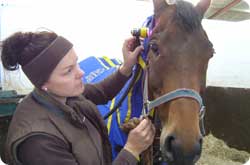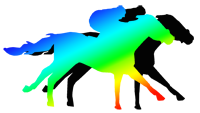Gentle Treatment for Head Shy or Horses Nervous Near Their Head or Ears
Many horses suffer from a "condition" called being "Head Shy" or they are very nervous and uncomfortable about being handled around the head and ears. The horse will often throw it's head out of the way, bear it's teeth, back away or be difficult to handle when it's owner wants to put a bridle or headcollar on or even just brush or wipe the horses face or neck. This can be as a result of bad or heavy hands on the reins, inaccurate aids, sharp teeth, badly fitting bridles, draw reins and other such equipment. As a result the muscles in the head, jaw and neck become tight and restricted, causing pain and / or discomfort and the horse becomes headshy.
I have studied and treated many horses with this problem and as an equine therapist I feel quite passionately about this. I have witnessed the relief and pleasure the horse gets when it has received just one of my treatments. Not only does the horse look relieved so does the owner and at times it can be quite emotional! Using a combination of Cranial Massage, Laser Therapy and McTimoney-Corley Therapy I have found that in many instances I can make an 80% improvement with just 1 treatment. Three treatments normally make a 100% improvement.
The horse has 15 muscles attached around the head, however, it only takes one tight muscle to contract and cause discomfort and have a knock on effect around the poll and ears. The discomfort can travel down into the withers and through the whole of the horses neck and under the scapula.
 Horse is relaxed during treatment
Horse is relaxed during treatmentTension or tightness in 3 key muscles contribute towards a horse being head shy - The Temporalis muscle, the Scutulum and the Crista Sagittalis muscles and they are all situated on the forehead of the horse. All 3 of the above muscles are focused on during treatment, as well as the horses cervical down to the scapula and withers. In addition, there is also cartilage that sits on top of the Temporalis muscle and small muscles that connect from the base of the ear to the scutulum and onto the other side of the skull. These muscles hold the ears in their basic position. The muscles that turn the ear attach the base of the ear to the back of the skull and nuchal ligament.
Horses use their ears to show emotion, there is one muscle in particular, the Parotidoauricularis muscle, this muscle is a key muscle linked to headshy horses and is responsible for pulling the ear downwards. Adjustments are made to relieve the pressure that the horse is experiencing.
The fantastic combination of laser and McTimoney-Corley works on the muscles, ligaments and the nervous system. Within minutes of treatment, the horse responds by sometimes closing its eyes, yawning, chewing and looking extremely relaxed. Occasionally a horse will appear to gurn! After the treatment has been carried out the horse looks more relaxed and is more accepting to the touching of his ears even for some horses that have been virtually impossible to touch for many years.
